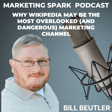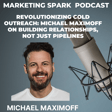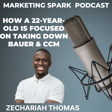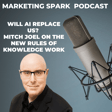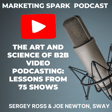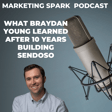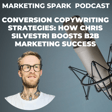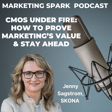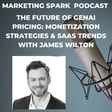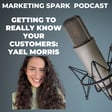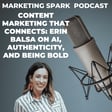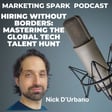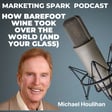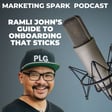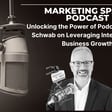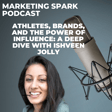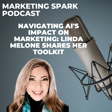Become a Creator today!Start creating today - Share your story with the world!
Start for free
00:00:00
00:00:01

The Growing Importance of Customer Intelligence
The more that you know your customers, the better.
That's Marketing 101.
As marketing attribution becomes increasingly more challenging, companies will need new tools to identify and engage prospects.
Getting this type of customer intelligence will allow them to make better and faster marketing, advertising, and sales decisions.
On the Marketing Spark podcast, Clearbit CMO Kevin Tate talks about how companies can use technology to identify their ideal customer profiles (ICPs), how to gain insight into what customers and prospects are thinking and the questions being asked, and how to identify Website visitors who don't provide any contact information.
We also took a look at Clearbit's marketing activities - content marketing and free tools.
Transcript
Why is customer insight crucial for marketing?
00:00:07
Speaker
How well do you know your prospects and customers? In theory, the more that you understand the people who matter, the more effective your marketing and sales are. Well, that's Marketing 101. So it's always surprising, even shocking, when companies struggle due to a lack of customer insight.
Who is Clearbit and what do they offer?
00:00:23
Speaker
As customer intelligence becomes more important, services like Clearbit are becoming a key part of the technology staff. On today's podcast, I'm talking to Kevin Tate, Clearbit's chief marketing officer. Kevin has more than 20 years of experience across the technology spectrum within sales, marketing, and product. Welcome to Marketing Spark. Hey, thanks for having me, Mark. Glad to be here.
How does Clearbit's technology aid targeted marketing?
00:00:47
Speaker
Let's start with Clearbit 101. Tell me at a high level, what does the platform do and how do customers use it? Clearbit helps companies grow faster and smarter using data. And broadly, there's a couple of different parts of that. First, we've got a market intelligence database that includes 100 plus attributes about every company with a website. How many employees do they have? What sector are they in? Are they located? What technologies do they appear to be using? And on and on and on.
00:01:16
Speaker
And so companies use that as like the foundation of a smart and focused go to market. But the second piece is how do you put that to work at all your different customer interaction points? So we have a platform that lets you use that to target ads more precisely or personalize your website with very specific information.
00:01:35
Speaker
or something we just launched last week, something that lets you see who's visiting your website but not filling out forms, and then know which of those companies fit your ICP and even who to contact at those companies to start a conversation.
00:01:51
Speaker
Now from the outside looking in, I think some people see Clearbit as an email retrieval service.
How has Clearbit evolved over time?
00:01:59
Speaker
You can easily find someone's email based on different factors, but it sounds like the platform has really expanded in recent years. Is that sort of an accurate assessment of where the company sits right now compared to six years ago when it started?
00:02:12
Speaker
Yeah, yeah. Six or seven years ago, I think a lot of people first saw a clear bit when we had our Gmail plugin that would let you figure out, hey, what's someone's email address based on my interaction or company?
00:02:27
Speaker
Yeah, we've come a long way since then. And really, the data activation platform now consists of three areas of putting that data to work. And not surprisingly, I kind of map to what a go-to-market team might want to focus on. Some are about improving the operations and the speed to lead around your ICP customers. There's a lot of automations and hooks and syncs to Salesforce.
00:02:53
Speaker
Then there's a bunch of stuff we do with the website specifically. How do you see who's coming but not identifying themselves? How do you personalize? How do you integrate with other things like chat? Then we even have an advertising piece that helps you fill the funnel with more good fit customers. But a lot of it really centers on your ICP and how do you really understand your ideal customer profile with as much precise information as you can, and then act on that to focus your funnel.
00:03:22
Speaker
I do want to talk about ICPs in a couple of minutes, but one of the things I wanted to focus on was the launch of Clearbit Capture. It's a free service that recently hit the market, and I'm really interested in the strategic plan when it comes to from a marketing and sales perspective, because obviously you can seed the market
00:03:42
Speaker
with a free tool like this. It provides some functionality. There's value in it. You get the weekly report that tells you who's hitting your website, which is awesome for a lot of people. It gives them some good insight. When you guys were developing that service, what were you thinking in terms of how you go to market? Was it a matter of broadening your footprint, adding utility? What was the thinking behind that?
00:04:05
Speaker
It's a great question and kudos to our growth team who for some time now has been investing in
How does Clearbit identify and utilize customer intent?
00:04:13
Speaker
free tools, like really useful tools for companies who are trying to use data to understand their market better. And when they created the weekly visitor report, the idea was how do we help companies gain insight into signals that were previously hidden? So one of the, it's funny, one of the original ways we talked about this in one of our eBooks was this idea of
00:04:38
Speaker
Overt intent signals you know people filling out a lead form raising their hand signing up for the webinar downloading the e-book all overt but if you're lucky. Only two percent of your web traffic is showing those types of over intent signals.
00:04:53
Speaker
And so the other 98% are showing, you might call covert intent signals. They're visiting the pages, they're checking out the pricing page. They're going to very specific documentation, create signals, first party intent signals that tell you a lot about what they're trying to do. But there's no way to act on those unless with something like the weekly visitor report, you have some insight into which companies are coming and experiencing your content and interested in what you have, but haven't explicitly
00:05:23
Speaker
filled out a lead form. So with the weekly visitor report,
00:05:26
Speaker
We wanted to provide companies with some of that insight and in a somewhat, you know, PLG style motion of our own. Let's give people a real taste of the potential here. And then you mentioned Capture, which we just launched last week. It's really a compliment to the weekly visitor report. If you are a Clearbit customer, then you can actually take those companies that are visiting your website that are a good fit based on very specific ICP criteria
00:05:55
Speaker
and add them directly to Salesforce as a new lead or as a new account. And we'll even put in key contacts based on roles and titles that you tell us you want to start a conversation
What sets Clearbit apart from competitors?
00:06:05
Speaker
with. And so that's the kind of end-to-end connection from, wow, I didn't even know they were here. Now I have a way to try to start a conversation with what appears to be a really good fit prospect.
00:06:18
Speaker
When I look at the technology landscape, the idea of identifying companies that hit your website, there's lots of different companies out there that are doing it. It is a very competitive marketplace. There's a lot of companies that are point solutions. And obviously what Clearbit is doing is becoming a platform, a multifaceted platform. And I do wonder from your perspective, and obviously you're going to be biased here, the way that a customer will look at point solutions versus platforms. Because if you're using point solutions, you're cobbling together your own technology stack.
00:06:48
Speaker
there are advantages best of breed, you pick what you want, you're not tied into your platform. But the con is that you're not everything is seamlessly tied together. And that sounds like the clear philosophy, let's get this unified platform for marketers and salespeople for that matter. So that's one stop shopping in terms of customer intelligence. It's a great point. And as you and as you say, there's, there's often both in the market. Part of our
00:07:16
Speaker
It's not so secret plan as you point out is to provide this foundation, but also be flexible enough that innovative marketers can choose those best of breed solutions for other parts of their stack. So a good example is, uh, we work very closely with, and in fact, power a lot of the chat providers and email marketing providers and personalization.
00:07:40
Speaker
platform providers, lead scoring and routing providers, those are all partners of ours. And we find that our customers want to be able to mix and match. They want to be able to architect a go-to-market stack that is truly strategic, like it's truly thoughtfully created for their go-to-market. And they also want to be able to power lots of different motions with that stack.
00:08:05
Speaker
Most of our customers, there's an inbound component. There's an outbound component. There might be a PLG or a free trial component. There's a high volume website and ad driven component. And that's okay. We can power lots of those. And to your point, I think the advantages of some of the more than an all in one or single solution can be tighter workflow. And you get, you know, you kind of have end to end reporting because you're doing one thing with it, but often you're just doing one thing with it.
00:08:35
Speaker
And so while there might be solutions that are better at, say, an enterprise sales motion, or how do you focus BDR's time in a specific way, we believe ultimately that the flexibility to use those solutions but not be hemmed in to a single motion is really important, especially during these times, as a lot of marketers are looking for new strategies and avenues.
00:09:01
Speaker
I spend a lot of time on LinkedIn, like a lot of people these days, and it is pretty amazing when you hear marketers talk about the fact that companies truly don't know their customers because a lot of marketing and sales aren't effective or fail because of a lack of customer insight.
00:09:18
Speaker
And I see this as a sort of marketing 101 or sales 101.
How should companies approach understanding their customers?
00:09:22
Speaker
The more you know about your customer, like I said off the top, the more effective you're going to be. Yet a lot of companies struggle with visibility. They just don't have a clear picture about who matters to them. Why do you think that is? Why do you think that
00:09:36
Speaker
marketers, for example, aren't spending hours and hours on the phone every week talking to customers, looking at social media, reading research reports. In some ways, you could argue a lot of them are making educated guesses, and that's not a good place to be. Yeah, and I think educated guess accounts for a lot of it. It's interesting because
00:09:56
Speaker
Maybe the difference is between making assumptions about your customer versus forming hypotheses and then being able to actually test those. I say that with love because I've spent my whole career in B2B go-to-market and you have to do both and you have to have conviction.
00:10:20
Speaker
The reality is that today there's so many great sources of data and signal that you can start to treat those more as hypotheses and things are going to change, right? So one of the things that we've been particularly working with customers on since we've seen a market shift
00:10:36
Speaker
And since we've seen customers take a new look at their customers around things like if and how their ICP has changed, especially the cost of customer acquisition for different segments of that ICP across different channels, and then to get more specific, maybe their buyer personas haven't changed, right? Maybe they're still being bought ultimately by the same types of roles, but maybe the jobs to be done of those personas have changed a little, right?
00:11:04
Speaker
A common one during these times is something that would be far too manual for anyone to not throw technology at. When budgets get tighter and things are a little different out there, yeah, maybe you can live with manual for a little while. You may find that what was a compelling reason to buy your product has become a little less so or doesn't stand up to the CFOs, do we have to have this right now?
00:11:28
Speaker
helping companies form those hypotheses and then really look at the data and look across their systems to find signal and see patterns is, I think, part of what keeps marketing interesting and exciting. But it does require that mindset, not from assumptions moving to more detestable hypotheses.
How does Clearbit leverage technology for customer insights?
00:11:51
Speaker
Let's talk a little bit more about ideal customer profiles and buyer personas.
00:11:56
Speaker
Question number one would be how do companies identify their ICPs?
00:12:01
Speaker
And number two would be the value of buyer personas. Buyer personas are a really great marketing exercise. We like to create them. They combine creativity and some objectivity and research, but we never use them. I mean, at best, sometimes you have posters on the wall, like the MailChimp example, but they usually collect us. Talk about both and talk about sort of how you develop and then how you actually extract value from them on a regular basis.
00:12:29
Speaker
So I'll say, and here speaking more as the head of marketing for Clearbit and how we think about it, ICP can be super powerful. And I think there's almost a top down and bottom up way of looking at the top down is whiteboard level market segmentation. And how do I think about who I'm going to go after and what my beach head and all those things are. But then there's also a bottom up piece where you can look into.
00:12:53
Speaker
your CRM, you can look into your customer history and events and say, who is it that ends up buying? Or who is it that ends up falling out at certain stages? And I think marrying those two, perhaps one is more strategy and one is more RevOps, how do you put those together into a view of what do you want your ICP to be and what is it really? And how do you find your way through that? I tend to believe, and our customers tell us, that some of the most actionable ICP criteria
00:13:22
Speaker
is also some of the simplest. How many employees do they have? What market or country are they in? What technology are they using? It can be often an eye-opening one. And using that criteria to then tailor your message to those buyers. So even starting a conversation knowing, well,
00:13:43
Speaker
you appear to use Stripe for payment processing and you use this for risk management. I know a lot more to start that conversation with you as a marketer or salesperson now than if I'm just addressing you as a financial services company.
00:13:57
Speaker
peel back the onion a little bit in terms of the Clearbit operating system and how you extract that insight into what customers and prospects are thinking. Because in theory, we're all supposed to talk to our customers. But in practice, at a company as big as Clearbit, how do you actually do it? What are the different ways that you do it?
00:14:18
Speaker
You know, is it regular conversations with new customers? Are you holding focus groups? Walk me through some of the sort of the tactical tools that you're using. For us, it, it plays on both the ICP and the buyer persona side. So kind of talk about both on the ICP side, the highest level, we break it into customer size. We have what we call growth commercial and enterprise customers. And, uh, we know that a lot of the themes and the value propositions and the use cases are similar.
00:14:44
Speaker
But what's interesting and different about those segments is often the role that Clearbit plays in their stack. A very early stage company, maybe they just got their Series A funding. A lot of those companies will buy Clearbit as the first or one of the first things in their Martech stack, because they'll say, I want to start with a strong data foundation. And this is going to be the thing that literally kind of holds my TAM and my ICP and the intelligence around it as I get going.
00:15:10
Speaker
And that's very different from say a company that has 250 or 500 people in it. They've got a number of things in their stack. They might have five or six big rocks in their Martek stack and they've got, they certainly got a CRM. They may or may not have a data warehouse. They've got several technologies on the website. So we're often one of five or six key pieces.
What frameworks does Clearbit use for marketing personas?
00:15:32
Speaker
And as I mentioned before, we work with a lot of those companies as partners. So engaging with them is often about, boy, how do we fit into their stack to make the whole thing better and smarter? And it depends a lot on the recipes that go with the technology they have. And then that gets even more complicated when you're talking about a company with 50,000 employees or 100,000 employees, where it's almost hard to talk about the company at that point, because it's happening inside of a department or a very specific go to market motion.
00:16:01
Speaker
Understanding that ends up being a big part of how we think about our ICP and then how we think about the buyer personas in there.
00:16:12
Speaker
You're absolutely right. Too often those things end up on a slide or a poster somewhere never to be used. We find it useful to think about our operations persona, which is often focused on data and integration and lead enrichment and intelligence. Our marketing persona is often focused on the website.
00:16:34
Speaker
How do I get more leads to the website? How do I get more higher quality? How do I make everything create more funnel from that, including advertising? And then we have the stack visionary, right? The person who is taking a broad look at this and saying,
00:16:48
Speaker
We want to start by understanding our ICP and then roll that intelligence through a whole strategic go-to-market motion that includes both those things. And those are different conversations, right? And they lead different places and different starting points. Returning to the idea of jobs to be done, I find that to be one of the more actionable parts of the persona. Once you get past, I don't know, Ali the operator,
00:17:17
Speaker
And you can actually say, okay, well, what's he trying to do? Oh, he's trying to figure out how to score leads instantly and route them based on. Okay. Got it. Let's talk about how we can make that job better versus kind of this abstract idea. So we think a lot about jobs to be done, how we enable them and why.
00:17:36
Speaker
we're able to do it in a way that's more valuable. Take me into the weeds. Let's go further in terms of Ollie the operator. Do you talk to Ollie the operator, call him out of the balloon, and say, hey, I want to find out how you do your job on a discovery call or a sales call? How do you find out what they're saying? Ollie is not one of our personas, by the way. We do have an optimizer, but it's saying Ollie the operator.
00:18:02
Speaker
Sounds like a children's book. It's a children's book for marketers. Yeah, so a couple things that end up mattering a lot. I will say one of them is we use Gong for all of our sales and CS interactions. Being able to use that for customer research
00:18:19
Speaker
is so, so powerful. And as both a marketing team and executive team, we'll share snippets and say, listen to this eight minutes where they talk about how they're moving from this platform to this more integrated way of going to market or how they're thinking about using our data in this way. And I mean, there's just no substitute for that customer voice.
00:18:42
Speaker
And then more recently, we have all hands meetings every week. We're all on Zoom all over the world. And we started bringing in customers who will do 10, 15 minute interview with our head of services and just focused on what problems are you trying to solve?
How should marketers adapt to economic changes?
00:18:58
Speaker
What role does Clearbit play? What should we be thinking about? And again, no substitute for hearing from those personas. And I think for us, what it has done is clarify
00:19:09
Speaker
those two personas in particular, that operations, RevOps, it's about systems and data and integration and speed to market and visibility and that marketing or demand team, who is just about how do I make sure I'm creating and capturing the very best leads and I'm helping my sales team make the most of them. Let's shift gears a little bit. And this goes back to your days on the revenue side.
00:19:37
Speaker
There's a lot of talk these days about marketers being revenue leaders, and this is particularly relevant because the focus these days is leads, leads, leads. Brand awareness, thought, leadership, that kind of thing is important, but leads seems to be the thing that a lot of companies are focused on. It becomes the priority in tougher times. Can you break down what
00:19:59
Speaker
marketers as revenue leaders actually means and why it's important. And how prevalent is this idea that a marketer has to be both? And I guess the other question would be, how does a marketer transform themselves into a revenue leader? Loaded question. Lots of lots of great questions in there. Well, so, uh, first sort of personal story. Um, I had, I'd been on the sales side and biz dev side for a few years. And then actually when I, when I first moved to Portland, I worked with this company.
00:20:27
Speaker
Unikrew the human capital management and I hadn't, I hadn't officially worked in marketing until then. What really drew me to it was the way marketing was organized aside from like corporate NPR was by industry. And so as the industry marketing lead, I took on our retail segment, which was our, our biggest segment. And as a marketer.
00:20:50
Speaker
to your question, my measure, my goal was not leads, it was revenue. It was to grow the ARR of our largest retail segment, quarter over quarter, year over year. And I think that ultimately is the starting point, right? If you want to position yourself as more of a revenue leader as a marketer, then make sure revenue is your target.
00:21:16
Speaker
and make sure that's the thing that you're gold on and planning for and creating a contract with sales around. Not only because it kind of gets a seat at that table, but it also just really widens the aperture, right? The field of view gets much broader for why and how you're organizing your go-to market if you're taking a quarter or a year's view of revenue, as opposed to what can, to your point, easily become a months or weeks or even days view of leads, leads, leads.
00:21:44
Speaker
And I think a lot of marketers are feeling coming out of this market shift and a little bit different landscape. The leads leads leads. It paints you in a corner after a while. When we're all competing, when you're doing that, we're all competing for the same demand gen dollars. We're all spending B2B ad promotion on the same three or four platforms and all the prices go up and all the yields go down. And a little, a little tire kicking in the funnel suddenly means that some of these things don't pencil anymore.
00:22:14
Speaker
And so what we're seeing is we're seeing marketers, I guess, swing that pendulum back a bit more to, okay, that was crazy. Now we need to make sure we're thinking about long-term awareness and interest and capturing those intent signals and building a more robust pipeline that we think about in terms of quarters, not what was my lead count today.
00:22:38
Speaker
Okay. I'm going to push back on that. Okay. Bring it, bring it. Although you're in the seat and you're seeing this in the weeds and strategically as well. I see a lot of desperation out there. I see a lot of companies that B2B SaaS companies that were fat and happy for two solid years as we went through this digital transformation revolution or evolution.
00:22:59
Speaker
I think a lot of marketers thought that the pickings were easy. You did your marketing thing and the leads were generated and you got the MQLs and the SQLs and life was good. And maybe marketers got a little complacent. They relied on the same platforms doing the same things. So a couple of questions for you. How has the economic landscape
00:23:24
Speaker
the changes in the economic landscape over the six months, what kind of impact have you seen in terms of the overall marketing landscape? And then how has that impacted the way that Clearbit is going to market and the kind of marketing that it's doing now versus what it did last year?
What is Clearbit's strategy for long-term engagement?
00:23:41
Speaker
I'll speak about Clearbit and then what we see in our customers. From a Clearbit standpoint, we are actually doing more what I talked about in terms of that pendulum swing. We were leaning further and further toward the end of last year into
00:23:57
Speaker
call it direct ad spend, trying to get people who were quote, ready to buy to raise that hand and fill out that form and let's get them in the pipe, get them in the pipe. And we still do some of that, but our focus now is more on, okay, look, our customers are very smart. Our prospects are very smart people. They know how to get a hold of us when they want to. Let's focus more on things like the weekly visit report.
00:24:23
Speaker
like the intent-based outreach playbook, which we just published today. Let's assume that with content and with tools and with a real empathy and educational bend to what we're doing,
00:24:38
Speaker
they'll raise their hand when they're ready. And I don't need a team to chase them saying, hey, you ready to raise your hand? You ready to raise your hand? And in the same way that maybe things were feeling for a while. So we're swinging in that direction. And it is a longer term bet. Now, we're somewhat fortunate in that
00:24:57
Speaker
Clearbit's role in companies' stack of really helping you get more out of the stack you have and wring more pipeline out of your existing investments, those things fit pretty well with a kind of tighter budget atmosphere, right? So we're benefiting from some of that as companies look to get more out of what they have. From a customer standpoint, I think you're spot on. Companies are kind of going one of two ways.
00:25:24
Speaker
Maybe they're swinging that pendulum back to, okay, got it. I can't just keep cranking up my, you know, social or display ad spend. But then we also see companies who are saying, yeah, you know what? Get on the phones, BDRs. Like we just, we got to pack the pipeline. I need, I, it was 10 calls a day. Now it's 15 calls a day. And that's not wrong. Uh, or 50 now it's a hundred. That's not wrong.
00:25:49
Speaker
But for those customers, we're trying to do everything we can to help them make sure they optimize that motion. They've got as much intelligence, as much relevance, as much intense signal to work from as they do that more aggressive outreach. I think it kind of depends on what market you're in and what kind of motions will work for you. But I think you're absolutely right. There's a lot of pressure out there right now.
00:26:14
Speaker
In terms of the kind of marketing that Clearbit does, content is obviously something that the company leans hard into. I understand webinars is also a very interesting vehicle, marketing vehicle for Clearbit. Are those the two main levers? What are the things that... Yeah, eBooks have been really big for us. I'm very fortunate to have a big wake of the boat there. And like I said, we just published another one today. We find that that
00:26:40
Speaker
the eBooks and the ability to use those, you know, kind of using a lot of that content on the blog or in your broader content promotion, it's a nice way to sort of give people a path, which may or may not lead to clear a bit, but it certainly leads to a more data-driven marketing approach. And that's kind of the shepherding that we try to do.
00:27:01
Speaker
We're also big on the tools, right? We talked about the weekly visitor report. We also have the TAM calculator. So actually creating meaningful and valuable tools, not just, Hey, if you try this, you can get a taste of what you're missing, but actually use this every week to figure out who's coming to your website and what you could be doing about it.
How does Clearbit build a community of marketers?
00:27:21
Speaker
I think those are big and we're going to be leaning more and more into the free tools as well and linking those to the paid products.
00:27:27
Speaker
The other that I wanted to talk to you about, and I mentioned all the time that I tend to spend on LinkedIn, which is, I guess, good and bad, is Clearbit's approach to LinkedIn. There are some companies that have fantastic LinkedIn pages. Gong is an example that people raise on a regular basis.
00:27:46
Speaker
As LinkedIn has become more of a content platform as opposed to HR, how is Clearbit using it? Have you figured out how to leverage it in terms of from a marketing and sales perspective, or is it still work in progress?
00:27:59
Speaker
Well, it's certainly still a work in progress, but I think you're absolutely right. It's funny, I remember this word, the plattisher from 10 years ago in content publishing and platforms. And I think in a way LinkedIn is becoming as much of that as its HR focus from before.
00:28:20
Speaker
We use LinkedIn as the primary channel for our content and announcements and discussion. Then to your point, it's interesting when I think about the voice of the customer that gets shared around and people can see how the market is reacting, it's very often screenshots of LinkedIn threads, which is funny. But that's where the conversation
00:28:46
Speaker
is happening and for us, it's often about like recipes. Oh, I'm using Clearbit plus this chat partner plus this personalization partner. Here's how I'm putting together. And you can see people having deep best practice dialogues in these LinkedIn chains. We're starting to look at it more and more like a community. And so, and then how do we participate and support the community of data-driven marketers who are sharing ideas and meeting one another and ultimately trying to further their companies and their career on LinkedIn?
00:29:15
Speaker
One final question and you mentioned the word community and there's a lot of buzz in the marketing world about community.
00:29:21
Speaker
What are your thoughts on community? People talk the talk about community, but walking the walk is a lot more difficult. Is that something that ClearBoot is looking at, is embracing? Like how do you equate or bring in community into the ecosystem? It's a great question and it's something we want to do more of. I'll say this fall, we participated in some events. We participated in HubSpot Inbound and Saster and the Dreamsforce and UpStars with Lean Data.
00:29:51
Speaker
And that was some of the first in-person events we've done a long time. And to me, it reminded me that community was for us as much about the partners and how we fit into their journeys and the way we are sort of better together in our customer stacks as it is the customers. And then hearing from the customers and hearing what, you know, what they're really working on, how excited they are about what they're doing, there's a,
00:30:19
Speaker
There's a big opportunity, I think, at Clearbit that I would like to figure out how to tap into, which is that I think because we work with a lot of innovative data-driven marketers and growth teams, they talk about and they tell us things about Clearbit.
00:30:39
Speaker
almost like it's their trade craft, almost like a designer would talk about the Adobe toolset. Well, this is how I do what I do, which isn't always the case, right? And so I'm trying to figure out as a marker, how do I harness and support that? And how do I help them do what they do and also advance their companies and their careers as a part of this community? And so I think there's a lot of opportunity there that we're just starting to tap into.
How should new users start with Clearbit?
00:31:08
Speaker
a company or a person is interested in getting started with Clearbit, where do they start? I think the easiest and best place to start is with that weekly visitor report I mentioned. You can go to Clearbit and you can sign up for a demo and you can look all around our data activation platform and see the pieces, but I think the weekly visitor report is one of the most fun ways to just start discovering pipeline and opportunity that you might otherwise have missed.
00:31:34
Speaker
Great. And if people want to learn more about you, I guess LinkedIn is the best place
Conclusion and contact information
00:31:38
Speaker
to go. Yeah, I'm on LinkedIn. Maybe not as much as you are, but close. Sounds good. Well, thanks for the great insight into what Clearbit's doing and the customer intelligence landscape. It's good to talk to people who are in the weeds and seeing how the market is evolving and shifting amid very, very challenging times. Well, thanks so much for having me, Mark.
00:32:01
Speaker
Thanks for listening to another episode of Marketing Spark. If you enjoyed the conversation, leave a review, subscribe via Apple Podcasts, Spotify, or your favorite podcast app, and share via social media. To learn more about how I work with B2B SaaS companies as a fractional CMO and strategic advisor, and as a position and messaging consultant, email mark at markevans.ca or connect with me on LinkedIn or talk to you soon.

